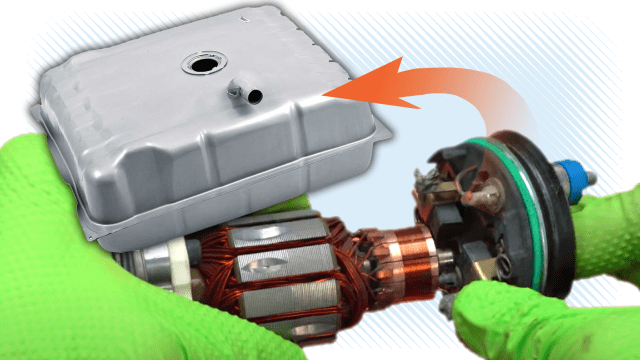Stephan Papadakis, tuner and owner of Papadakis Racing, is here to teach us more about our machines. In this teardown video of two types of fuel pumps, he once again digs into the workings of the parts that make our cars go.
Papadakis disassembles the pumps by clamping them in a lathe and using a parting tool to separate their enclosures. It looks a little like using a can opener to dig into some Ranch Style Beans, except that the fuel inside these pumps is, presumably, less viscous and tasty than the beans.
After removing the top and bottom sections, Papadakis exposes the electromechanical bits that help make all the lovely explosions inside our engine cylinders possible. The video focuses on two types of pumps. The first is a positive displacement roller vane pump, commonly used in high-performance applications. The second is a reactive turbine pump, and it tends to be quieter. This is the kind of pump found in street-going cars.
Papadakis explains that the pumps are powered electrically, and as you’d expect, they draw in stored fuel, then send it to the engine at higher pressure. The pump is composed of an electric motor and the pumping mechanism (turbine or roller/impeller) itself. The electric motor is much like an alternator or starter; as it turns it spins the pump section.
A roller vane pump does well with engines that require a lot of pressure, those requiring anywhere from 2.8 to 7 kilograms of force per square cm, Papadakis says in the course of the teardown. These pumps are powerful enough to flow fuel for engines producing over 745,700 Nm, which is why Papadakis Racing uses this type in its competition cars.
Papadakis claims the pumps are quite simple, but one standout of his teardown is that the fuel is actually flowing in and around the electric motor in the pumps. How is that possible? Well, according to the video, hydrocarbon fuel is not very conductive at all. The fuel flows around the electric motor and cools it down. In other words, the electric motor is liquid-cooled.
The second type of pump, the reactive turbine design, is a little more pedestrian. These submerged pumps use an electric motor to push fuel through a small turbine that spins and sends the fluid through the lines under pressure — in my car’s case, lines so leaky that I can’t drive anywhere without smelling a little bit like gasoline.
The standout bits of info Papadakis shares while tearing down the turbine pump reflect two ancient tenets of gearhead wisdom. The first is that you should avoid running your car’s fuel supply all the way to empty. This really can damage the turbine-type pumps. The second is that, due to the way these operate, debris in the pump can render it useless, but giving it a knock or two may dislodge the debris and get the pump working again. You give it a whack, the particle dislodges, fuel goes back into the lines and you are on the road again.
Like the previous teardowns, this one is thorough and offers excellent insight about the coordinated workings of smaller machines needed to power our cars. It’s not so long that you can’t watch it in one sitting, but it’s not so short that it lacks technical chops. Don’t miss the other vids in the series, either.
